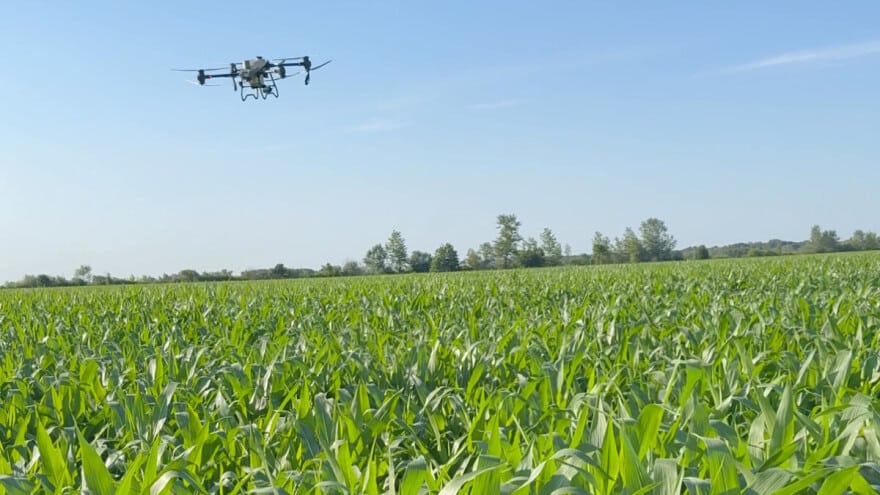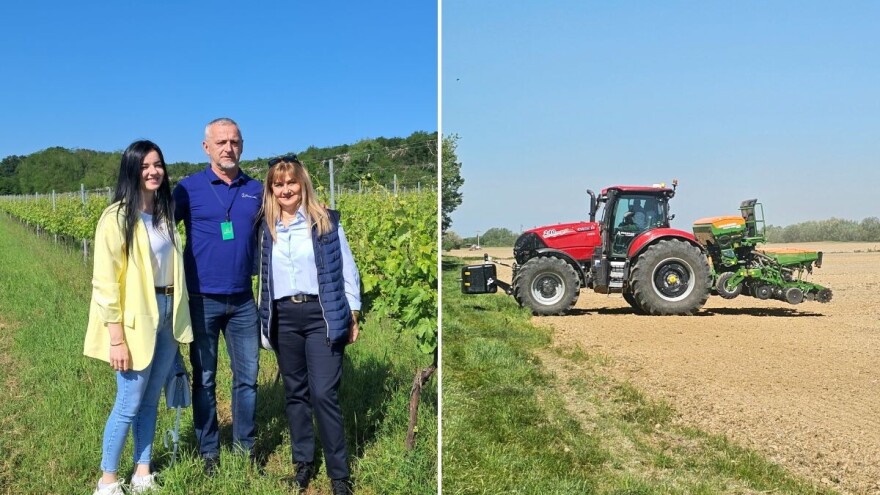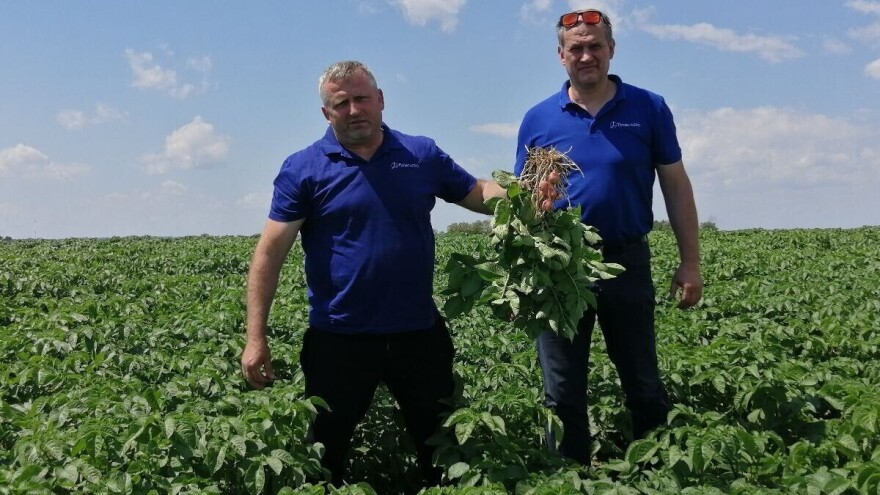Enosophia in Feričanci processes 800 to 1,200 tons of grapes annually and produces between 600,000 and 800,000 liters of wine, with a cellar capacity of two million liters. “We are young, ambitious, and not afraid of challenges,” said Danijel Bosak, Head of the Viticulture Department.

In the heart of Slavonia, in the wine-growing region of Feričanci, lies the Enosophia winery, the modern face of the former Feravina, which today combines centuries-old tradition with an innovative approach to wine production.The investment and rebranding process was initiated in 2020 with a clear goal: to revive the spirit of Slavonian vineyards and bring it closer to new generations of wine enthusiasts.
From Feravino to Enosophia, the philosophy of wise wine”Feravino had been a recognized brand for many years, but the market demanded change, a fresh approach, new energy, and a visual identity,” explains Danijel Bosak, Head of the Viticulture Department at Enosophia Winery, adding: “This is how Enosophia was born, which translates to the wisdom of wine. We retained the tradition, but we enhanced it with a modern story.”The rebranding was not just a change of name, but of philosophy. Authentic Slavonian wines remained in focus, but they were presented in a contemporary, interactive way. Lines like Trs No. 5 Graševina and the rosé Matarouge have become symbols of the new direction, with innovative labels that “come to life” with the help of mobile apps and artificial intelligence.”For example, the Trs No. 5 label responds when scanned, transforming into a music equalizer that plays a melody as you drink the wine. With Matarouge, you can see world rosé wine regions and a live stream from our vineyards,” Bosak reveals.

Changes have also affected other lines of wine: Dika retained its name but received a new, more elegant visual, while Miraz was redesigned in accordance with the brand’s philosophy. Today, Enosophia thus encompasses a wide range of wines, from fresh, modern sparkling wines to serious red labels intended for gastronomy.
153 hectares of vineyards, the kingdom of Graševina and Frankovka. Today, the winery has 153 hectares of vineyards, of which 137 ha are in production, while the rest are in the phase of investment and conversion. “Our production is balanced, meaning we have 50% white and 50% red varieties,” explains Bosak. “Graševina dominates with 54 hectares and Frankovka with 40 hectares. These are our queens. Alongside them, we also cultivate Chardonnay, Pinot Blanc and Noir, Merlot, Cabernet Sauvignon, Sauvignon Blanc, Rhine Riesling, Cabernet Franc, Syrah, and several Muscat varieties.” Enosophia gradually renews the vineyards and introduces varieties attractive to the modern market. Recently, they cleared older Frankovka vineyards and planted new Graševina and Sauvignon Blanc, further diversifying their offerings and creating raw material for sparkling wines, fresh wines, as well as those aged in wooden barrels.
Of the total area, 60 hectares are in the Eco scheme, where exclusively natural and organic fertilizers are used. “Our goal is a sustainable vineyard, soil that breathes and gives, not one that is depleted,” adds Bosak.
Science in the service of the vineyard – cooperation with Timac Agro
A significant step forward in vineyard modernization was achieved through cooperation with the company Timac Agro Croatia, which began in 2023. “We were looking for partners who could help us optimize production to reduce the number of passes, losses, and labor use, while maintaining a high level of quality. Timac Agro enabled us to do exactly that,” says Bosak.

According to him, Timac fertilizers require a lower dose per hectare, are applied more quickly, and have more efficient nutrient utilization, which is crucial in modern viticulture.”With their products, we have achieved better soil condition, and through the calcification process, we bring the soil to an optimal pH so that nutrients are more available to the vines,” adds Bosak.
Precise nutrition and soil biostimulation
Mirko Roguljić, Key Account Manager at Timac Agru, explains that the collaboration started experimentally but quickly expanded.
“We started with trials, and today Enosophia uses our fertilization on 100% of its areas,” he tells us.
For the organic part of the vineyard, they use Physio Natur PKS, a granulated fertilizer with an eco-certificate, while Duofertil 36 is applied in conventional production. Both, they confirm, have high solubility and efficiency, with added calcium, sulfur, and boron, which improve flowering and vine resistance.
Due to the acidic soils around Feričanci, special attention is paid to calcification and improving soil structure. “This raises the pH and unlocks phosphorus and potassium that were previously blocked, providing the plant with more accessible nutrients,” adds Roguljić.
In the next period, they plan to test the biostimulants Seactiv Gold and Seactiv Elite, as well as the product Seactiv Rame, based on copper and amino acids, which is a novelty on the Croatian market.

Patented solutions and a scientific approach: ‘Our MPPA DUO patent prevents the blockage of phosphorus and potassium, whether it is low or high soil pH or the soil structure itself, keeping nutrients available to the plant. In the organic PKS fertilizer, we use the Physio+ additive, which contains aminopurine compounds. They stimulate the growth of root hairs that absorb nutrients,’ explains Nina Misirača, product specialist at Timac Agra. In addition, all fertilizers use marine calcium, which is highly porous and quickly soluble, allowing faster action and better plant resistance to stress and drought, which is a key factor in increasingly challenging climatic years. Thanks to the use of Timac Agra fertilizers, despite the drought in June and hail in July, the vineyards of Enosophija recorded, they say, an exceptionally good harvest. ‘The rainfall in July came at just the right time and saved the crop,’ says Bosak. ‘Graševina produced healthy, ripe clusters, with sugars that enabled wines with ideal alcohol content of 12 to 12.5%.’After a challenging 2023 and an unpredictable 2024, this is a year that will be remembered.
The harvest began on August 19, with grapes for the base wine of future sparkling wines, and continued with Chardonnay, Pinot Blanc, Frankovka, and Graševina. “The result is fresh, elegant wines with pronounced varietal character and moderate alcohol, exactly what the market is looking for,” concludes Bosak.
Nove etikete i nova energija
Uz uspješne etikete Trs No.5 i Matarouge, Enosophia je prošle godine lansirala novu etiketku pod nazivom Nobleman od sorte Sauvignon bijeli, stepenica više u izričaju ove sorte, koja se nadovezuje na obiteljsku tradiciju i restaurirani hotel Kurija Mihalović. Linija Dika danas broji osam etiketa, dok se segment pjenušaca Memoria razvija u smjeru novih sorti i metoda, uključujući i klasičnu fermentaciju u boci.

The winery annually processes 800 to 1,200 tons of grapes and produces 600,000 to 800,000 liters of wine, with a cellar capacity of two million liters. They distribute their wines through the HoReCa channel, retail chains in Croatia, and export to Germany, the Netherlands, the United Kingdom, Japan, China, and the USA.
Enosophia today represents the best of Feričanci, a combination of tradition, knowledge, and youthful ambition. In collaboration with Timac Agro, they are systematically building a sustainable future, investing in soil, science, and people.
“This is a process that will last up to ten years, but we are already noticing the first positive results,” says Bosak, concluding: “We are young, ambitious, and not afraid of challenges. Our philosophy is clear – to create wines that tell the story of our region, but in a language understood by the whole world.”



